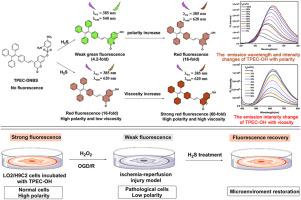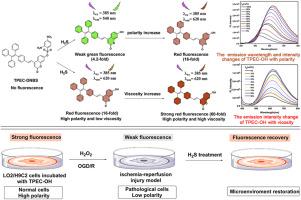AIE-TICT 荧光探针级联对 H2S、极性和粘度敏感,可跟踪缺血再灌注损伤细胞模型中的微环境变化
IF 5.7
2区 化学
Q1 CHEMISTRY, ANALYTICAL
引用次数: 0
摘要
背景缺血再灌注损伤是心脑血管疾病的常见原因。再灌注过程中的再氧导致活性氧(ROS)的过度产生。作为一种抗氧化剂,H2S 可以清除 ROS,抑制氧化应激和炎症反应,从而减轻缺血再灌注损伤。在这一过程中,细胞微环境(极性或粘度)的变化尚未得到充分讨论。为了实时跟踪 H2S 治疗缺血再灌注损伤过程中细胞微环境的变化。结果 我们设计并合成了一种荧光探针 TPEC-DNBS,它能对 H2S 和微环境产生级联反应。TPEC-DNBS 对 H2S 产生高选择性和高灵敏度的反应后,会产生一个中间体 TPEC-OH,该中间体可进一步对极性和粘度产生反应。此外,由于聚集诱导发射(AIE)和扭曲分子内电荷转移(TICT)效应,极性可促进 TPEC-OH 的荧光发射波长和强度产生双重响应特性,其变化趋势(从低极性时的弱绿色荧光到高极性时的强红色荧光)与传统极性探针的变化趋势(从低极性时的强绿色荧光到高极性时的弱红色荧光)相反。粘度只能引起荧光强度的变化。通过构建缺血再灌注的心肌细胞模型和肝细胞模型,我们进一步证明了缺血再灌注损伤后,细胞处于低极性环境中,经 H2S 处理后,微环境可以恢复。该探针为实时跟踪缺血再灌注损伤 H2S 处理前后细胞微环境(极性或粘度)的变化提供了更直观、更方便的条件。本文章由计算机程序翻译,如有差异,请以英文原文为准。


An AIE-TICT fluorescence probe cascade responsive to H2S, polarity and viscosity to track microenvironment changes in cellular model of ischemia-reperfusion injury
Background
Ischemia-reperfusion injury is a common cause of cardiovascular and cerebrovascular diseases. The reoxygenation during reperfusion leads to an overproduction of reactive oxygen species (ROS). As an antioxidant, H2S can scavenge ROS to inhibit oxidative stress and inflammatory reaction, thus attenuating ischemia-reperfusion injury. In this process, the changes of cellular microenvironment (polarity or viscosity) have not been fully discussed. In order to real-time track the changes of cellular microenvironment during the treatment of ischemia-reperfusion injury with H2S. It is necessary to develop highly selective and sensitive probes that can cascade response to hydrogen sulfide and cellular microenvironment.
Results
We designed and synthesized a fluorescent probe TPEC-DNBS which can produce cascade response to H2S and microenvironment. An intermediate TPEC-OH is produced after highly selective and sensitive response to H2S, which can further respond to polarity and viscosity. In addition, due to the aggregation-induced emission (AIE) and twisted intramolecular charge transfer (TICT) effects, polarity can promote the fluorescence emission wavelength and intensity of TPEC-OH to produce double response characteristics, and its change trend (from weak green fluorescence at low polarity to strong red fluorescence at high polarity) is opposite to that of traditional polar probes (from strong green fluorescence at low polarity to weak red fluorescence at high polarity). Viscosity can only induce the change of fluorescence intensity. By constructing the cardiomyocyte model and hepatocyte model of ischemia-reperfusion, we further prove that after ischemia-reperfusion injury, the cells are in an environment of low polarity, and the microenvironment can be recovered after H2S treatment.
Significance
An AIE-TICT fluorescence probe capable of cascading responses to H2S, polarity and viscosity was constructed by using tetraphenylethylene and coumarin moieties. This probe provides a more intuitive and convenient condition for real-time tracking the changes of cellular microenvironment (polarity or viscosity) before and after H2S treatment of ischemia-reperfusion injury.
求助全文
通过发布文献求助,成功后即可免费获取论文全文。
去求助
来源期刊

Analytica Chimica Acta
化学-分析化学
CiteScore
10.40
自引率
6.50%
发文量
1081
审稿时长
38 days
期刊介绍:
Analytica Chimica Acta has an open access mirror journal Analytica Chimica Acta: X, sharing the same aims and scope, editorial team, submission system and rigorous peer review.
Analytica Chimica Acta provides a forum for the rapid publication of original research, and critical, comprehensive reviews dealing with all aspects of fundamental and applied modern analytical chemistry. The journal welcomes the submission of research papers which report studies concerning the development of new and significant analytical methodologies. In determining the suitability of submitted articles for publication, particular scrutiny will be placed on the degree of novelty and impact of the research and the extent to which it adds to the existing body of knowledge in analytical chemistry.
 求助内容:
求助内容: 应助结果提醒方式:
应助结果提醒方式:


